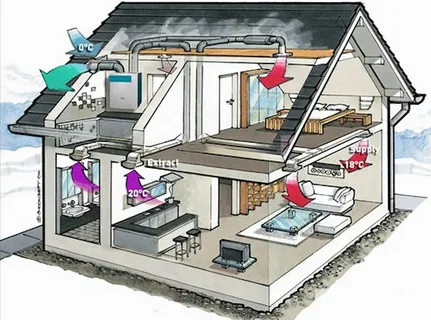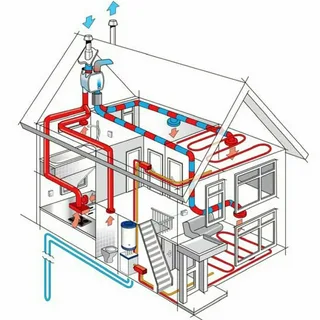Every day, we take approximately 20,000 breaths without even thinking about it. But have you ever stopped to consider the air quality you’re breathing in? Unfortunately, many of us neglect the importance of indoor air quality, assuming that as long as we keep our homes clean, the air must be clean, too. However, the truth is that the air inside our homes can be up to five times more polluted than the air outside. Whole House Ventilation,
Full House Ventilation System,
Whole House Ventilation System,
Domestic Heat Recovery Ventilation,
Whole House Heat Recovery Ventilation System
Understanding The Importance Of Indoor Air Quality
Indoor air quality is a fundamental aspect of a healthy living environment. The concentration of indoor pollutants can significantly exceed that of the outdoor environment, largely due to insufficient ventilation and various pollutant sources such as cleaning products, furnishings, and building materials. These pollutants can range from dust and allergens to chemical vapours and gases. Poor indoor air quality exposure can have various health implications, with symptoms ranging from minor irritations like headaches and fatigue to more severe conditions such as allergies, asthma, and other respiratory diseases.
In extreme cases, some indoor air pollutants, such as radon and second-hand smoke, are known to be carcinogenic. Aside from health implications, poor indoor air quality can also affect comfort and productivity levels. It has been linked to reduced concentration and cognitive performance, further emphasising its influence on overall well-being. Keeping a clean, dust-free home can help improve indoor air quality, but it more oftneededto the variety of pollutants and their sources. Therefore, implementing a comprehensive solution that addresses ventilation, pollutant removal, and monitoring is crucial to enhancing indoor air quality.
The Role Of Full House Ventilation System In Improving Air Quality
A full-house ventilation system is essential in maintaining and enhancing indoor air quality. These systems are designed to reduce and eliminate indoor air pollutants by creating a constant flow of air within the house, subsequently improving overall air quality. They function by systematically extracting stale and contaminated air inside the house and replacing it with fresh, clean outdoor air. This process is instrumental in diluting and removing airborne contaminants, including dust, allergens, chemicals and even bacteria. Various types of full house ventilation system, such as balanced, exhaust, and supply systems, are available, each offering unique benefits and functionality.
Some advanced ventilation systems also come equipped with heat recovery capabilities. These systems assist in improving air quality and simultaneously conserve energy, making them an efficient and eco-friendly option for homeowners. However, it’s crucial to note that for these systems to function optimally, they must be correctly installed and regularly maintained. Full-house ventilation systems play a pivotal role in creating a healthier and more comfortable living environment by ensuring that fresh air circulates throughout the house.
Air Filters And Purifiers: Additional Ways To Improve Indoor Air Quality
Air filters and purifiers offer additional protection in maintaining and improving indoor air quality. These devices operate as complementary tools to whole-house ventilation systems by trapping and eliminating various airborne pollutants. Air filters are integrated into the ventilation system, and their primary function is to trap and hold pollutants such as dust, allergens and other small particles that circulate within the air.
They are often graded on their Minimum Efficiency Reporting Values (MERV), a system that rates their effectiveness in filtering out different-sized particles. Higher MERV ratings signify a greater filtering capability. Regular maintenance and replacement of these filters are critical to ensure they function optimally. On the other hand, air purifiers work independently and can be stationed in specific areas of the house. These devices utilise various methods to cleanse the air, such as activated carbon filters, which are effective in adsorbing gaseous pollutants.
Keeping Indoor Air Clean With Whole House Ventilation System
Whole House Ventilation System is remarkable instruments that preserve a healthy indoor environment. They operate on a straightforward yet effective principle of extracting stale indoor air and replacing it with fresh air from the outside. This process systematically eradicates various contaminants and pollutants from the living space. The cycle of air replacement ensures that the indoor air remains refreshed and free from harmful particles.
With different types of whole-house ventilation systems available, each offers unique benefits. For instance, systems with heat recovery capabilities improve air quality and promote energy efficiency by harnessing heat from the extracted air. Other systems, known as energy recovery ventilators, can also moderate humidity levels within the home, creating a comfortable and healthy atmosphere.
Air filters and purifiers can complement these ventilation systems. By trapping or eliminating additional airborne contaminants, these tools further enhance indoor air quality. Whether eliminating dust, dander, allergens or reducing the presence of chemicals, they work hand in hand with the ventilation systems to maintain a healthy living environment.
Controlling Indoor Pollutants: Domestic Heat Recovery Ventilation Explained
A domestic heat recovery ventilation (HRV) system is a cutting-edge solution for managing indoor air quality while promoting energy efficiency. The system operates on the principle of extracting heat from stale indoor air before it is expelled outside. This captured heat is used to pre-warm the fresh, cool outdoor air. At the heart of the HRV system lies a heat exchanger, facilitating heat transfer between outgoing and incoming air streams. The critical point is that these air streams do not mix.
This heat exchange process ensures that the warmth is retained within the house, reducing the need for additional heating and, in turn, conserving energy. However, the system’s function extends beyond energy conservation. The HRV system also plays a pivotal role in regulating indoor air quality. As the stale, contaminated air is continuously expelled, it is replaced by fresh, filtered air from the outside.
This dual action of the HRV system significantly reduces indoor pollutants, including allergens, volatile organic compounds and dust particles. Domestic HRV systems often come equipped with built-in filters, which enhance their pollutant-controlling capabilities. These filters help to trap any harmful particles in the incoming air before it is circulated indoors. This process, combined with the constant replacement of stale air, ensures the indoor environment remains clean and healthy.
Monitoring And Maintaining Air Quality Levels
Monitoring indoor air quality and maintaining ventilation systems effectively are two pivotal components of achieving a healthy indoor environment. This involves regular indoor air testing for contaminants such as mould, dust, allergens, and volatile organic compounds, among others. Air quality monitors can be employed for this purpose, providing accurate readings and identifying potential areas of concern. This information can be used to address any issues promptly, preventing the build-up of harmful pollutants. Regular maintenance of the house ventilation system is vital in tandem with monitoring air quality. This ensures the system’s optimal performance, prolonging its lifespan and maximising its efficacy in enhancing indoor air quality. Maintenance tasks typically include:
- Cleaning or replacing air filters.
- Checking for leaks or blockages.
- Inspecting the system for signs of wear and tear.
Additionally, regular servicing by professionals is recommended to ensure the system functions at its full capacity.
Maximising Airflow: Tips For Choosing The Whole House Heat Recovery Ventilation System
When selecting a whole house heat recovery ventilation system, several factors should be considered to ensure optimal airflow and performance. Here are some tips to guide the decision-making process:
- First, understand the house’s air capacity needs. A system that is too small may not adequately ventilate the entire space, while one that is too large could be inefficient.
- Consider the energy efficiency of the system. As discussed earlier, systems with heat recovery capabilities not only improve air quality but also help reduce energy consumption.
- Examine the system’s filtration capabilities. The ability to filter out pollutants, allergens and other harmful particles is crucial for maintaining high-quality indoor air.
- Look for a system with easy maintenance features. The longevity and performance of these systems rely heavily on routine maintenance, so it’s important to choose a user-friendly system.
- Consider the noise levels of the system. Whilst essential for air quality, the system should not cause disruptive noise levels within the living environment.
- Assess the installation requirements. Depending on the design and structure of the house, some systems may be more suitable than others.
- Lastly, consult with a professional. Ventilation experts can provide personalised advice and recommendations based on the specific needs and characteristics of the house.
Choosing the right whole-house heat recovery ventilation system requires careful thought and consideration. By considering these tips, homeowners can make an informed decision that will contribute to a healthier, cleaner indoor environment.
 Balancing Energy Efficiency With Indoor Air Quality
Balancing Energy Efficiency With Indoor Air Quality
Navigating the fine line between energy efficiency and indoor air quality can seem complex. A common misconception is that these two aspects are at odds with one another, with energy-saving practices often viewed as leading to substandard air quality. However, striking a balance between them is not only possible but also crucial for a healthy and sustainable living environment.
Whole-house ventilation systems, particularly those equipped with heat recovery capabilities, illustrate the perfect synthesis of these two elements. By design, these systems replace stale indoor air with fresh outdoor air, effectively boosting the air quality. Simultaneously, they recover heat energy from the outgoing air, reducing the energy needed to warm the incoming air. This dual functionality exemplifies how ventilation systems can contribute to maintaining air quality without compromising energy efficiency.
Additional measures can also be taken to balance energy usage with indoor air quality. For instance, opting for energy-efficient air filters and purifiers helps reduce energy consumption whilst ensuring a clean, healthy indoor environment. Regular maintenance and servicing of these systems are crucial to maintaining their energy efficiency and functionality.
FAQs
What Is A Whole-House Ventilation System?
Whole-house ventilation systems provide uniform ventilation throughout the house, replacing stagnant indoor air with fresh outdoor air. This significantly aids in the dilution and removal of indoor pollutants.
What Are The Health Implications Of Poor Indoor Air Quality?
Poor indoor air quality has been linked to various health conditions, such as allergies, asthma, and other respiratory diseases. These can be triggered by pollutants like dust, allergens, and chemicals from household agents.
How Do Air Filters And Purifiers Complement Whole-House Ventilation Systems?
Air filters and purifiers work hand in hand with ventilation systems. Filters trap airborne pollutants, while purifiers eliminate or reduce airborne contaminants, providing an additional layer of air quality control.
How Does A Domestic Heat-Recovery Ventilation System Work?
A domestic heat-recovery ventilation system refreshes indoor air while harnessing heat from the exiting stale air. This heat is used to pre-warm the fresh incoming air, marrying ventilation with energy efficiency.
How Can One Maintain Optimum Functionality Of The Ventilation System?
Regular monitoring and maintenance are crucial for the longevity and performance of the ventilation systems. This includes following manufacturers’ guidelines for replacing filters and servicing units.
Conclusion
In summary, the health implications of indoor air quality and general well-being cannot be overstated. The introduction of whole-house ventilation systems has proven to be a game changer, significantly improving indoor air quality by mitigating pollutants and ensuring a constant fresh air cycle. Additional strategies like integrating air filters, cleaners, and cutting-edge domestic heat recovery ventilation systems have further reinforced these efforts.
| Other Good Articles to Read |
| Blogs Rain |
| Cme Blog Spot |
| Garcias Blogs |
| Yyc Blogs |
| Blogs-Hunt |
| Impact-Blog |
| Smarty Blogs |
| Ed Blog |
| Mo Blogs |
| Blogs Em |
| Blogs T |
| Related Business Listings |
| Contact Directory |
| Local Business Profiles |
